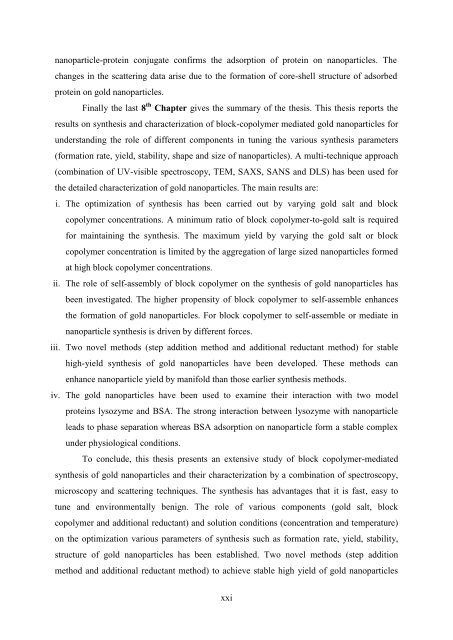PHYS01200704032 Debes Ray - Homi Bhabha National Institute
PHYS01200704032 Debes Ray - Homi Bhabha National Institute
PHYS01200704032 Debes Ray - Homi Bhabha National Institute
You also want an ePaper? Increase the reach of your titles
YUMPU automatically turns print PDFs into web optimized ePapers that Google loves.
nanoparticle-protein conjugate confirms the adsorption of protein on nanoparticles. The<br />
changes in the scattering data arise due to the formation of core-shell structure of adsorbed<br />
protein on gold nanoparticles.<br />
Finally the last 8 th Chapter gives the summary of the thesis. This thesis reports the<br />
results on synthesis and characterization of block-copolymer mediated gold nanoparticles for<br />
understanding the role of different components in tuning the various synthesis parameters<br />
(formation rate, yield, stability, shape and size of nanoparticles). A multi-technique approach<br />
(combination of UV-visible spectroscopy, TEM, SAXS, SANS and DLS) has been used for<br />
the detailed characterization of gold nanoparticles. The main results are:<br />
i. The optimization of synthesis has been carried out by varying gold salt and block<br />
copolymer concentrations. A minimum ratio of block copolymer-to-gold salt is required<br />
for maintaining the synthesis. The maximum yield by varying the gold salt or block<br />
copolymer concentration is limited by the aggregation of large sized nanoparticles formed<br />
at high block copolymer concentrations.<br />
ii. The role of self-assembly of block copolymer on the synthesis of gold nanoparticles has<br />
been investigated. The higher propensity of block copolymer to self-assemble enhances<br />
the formation of gold nanoparticles. For block copolymer to self-assemble or mediate in<br />
nanoparticle synthesis is driven by different forces.<br />
iii. Two novel methods (step addition method and additional reductant method) for stable<br />
high-yield synthesis of gold nanoparticles have been developed. These methods can<br />
enhance nanoparticle yield by manifold than those earlier synthesis methods.<br />
iv. The gold nanoparticles have been used to examine their interaction with two model<br />
proteins lysozyme and BSA. The strong interaction between lysozyme with nanoparticle<br />
leads to phase separation whereas BSA adsorption on nanoparticle form a stable complex<br />
under physiological conditions.<br />
To conclude, this thesis presents an extensive study of block copolymer-mediated<br />
synthesis of gold nanoparticles and their characterization by a combination of spectroscopy,<br />
microscopy and scattering techniques. The synthesis has advantages that it is fast, easy to<br />
tune and environmentally benign. The role of various components (gold salt, block<br />
copolymer and additional reductant) and solution conditions (concentration and temperature)<br />
on the optimization various parameters of synthesis such as formation rate, yield, stability,<br />
structure of gold nanoparticles has been established. Two novel methods (step addition<br />
method and additional reductant method) to achieve stable high yield of gold nanoparticles<br />
xxi

















